Fairphone: A Case Study on Social Entrepreneurship
VerifiedAdded on 2023/01/18
|10
|2031
|75
AI Summary
This case study explores the business model and practices of Fairphone, a social entrepreneurship venture that promotes fair working conditions and environmental sustainability. It discusses the traits of an entrepreneur evident in Fairphone's working model and the challenges faced by social entrepreneurs. The study also highlights how social entrepreneurship can create positive brand perception and contribute to a triple bottom line.
Contribute Materials
Your contribution can guide someone’s learning journey. Share your
documents today.

Secure Best Marks with AI Grader
Need help grading? Try our AI Grader for instant feedback on your assignments.
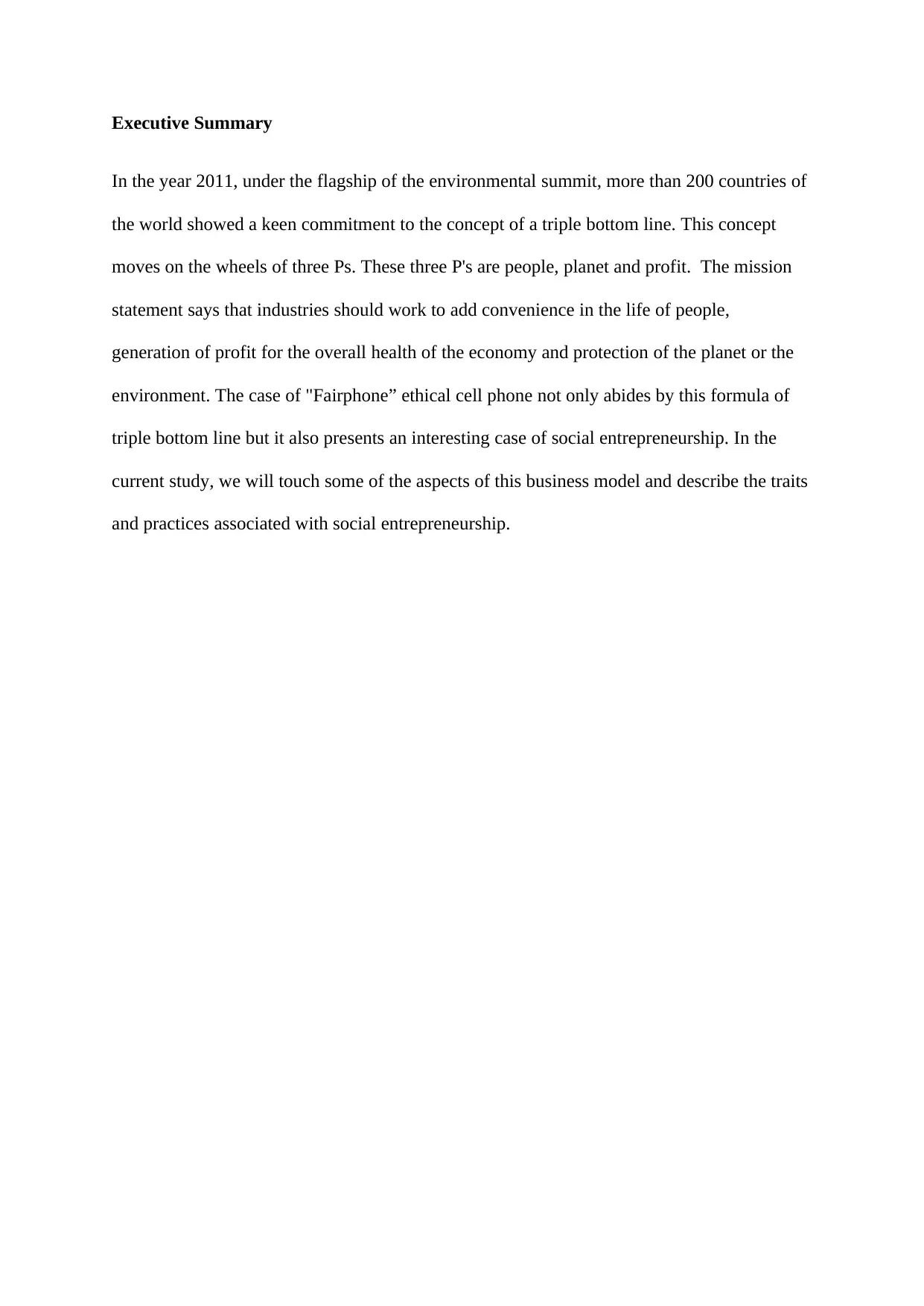
Executive Summary
In the year 2011, under the flagship of the environmental summit, more than 200 countries of
the world showed a keen commitment to the concept of a triple bottom line. This concept
moves on the wheels of three Ps. These three P's are people, planet and profit. The mission
statement says that industries should work to add convenience in the life of people,
generation of profit for the overall health of the economy and protection of the planet or the
environment. The case of "Fairphone” ethical cell phone not only abides by this formula of
triple bottom line but it also presents an interesting case of social entrepreneurship. In the
current study, we will touch some of the aspects of this business model and describe the traits
and practices associated with social entrepreneurship.
In the year 2011, under the flagship of the environmental summit, more than 200 countries of
the world showed a keen commitment to the concept of a triple bottom line. This concept
moves on the wheels of three Ps. These three P's are people, planet and profit. The mission
statement says that industries should work to add convenience in the life of people,
generation of profit for the overall health of the economy and protection of the planet or the
environment. The case of "Fairphone” ethical cell phone not only abides by this formula of
triple bottom line but it also presents an interesting case of social entrepreneurship. In the
current study, we will touch some of the aspects of this business model and describe the traits
and practices associated with social entrepreneurship.
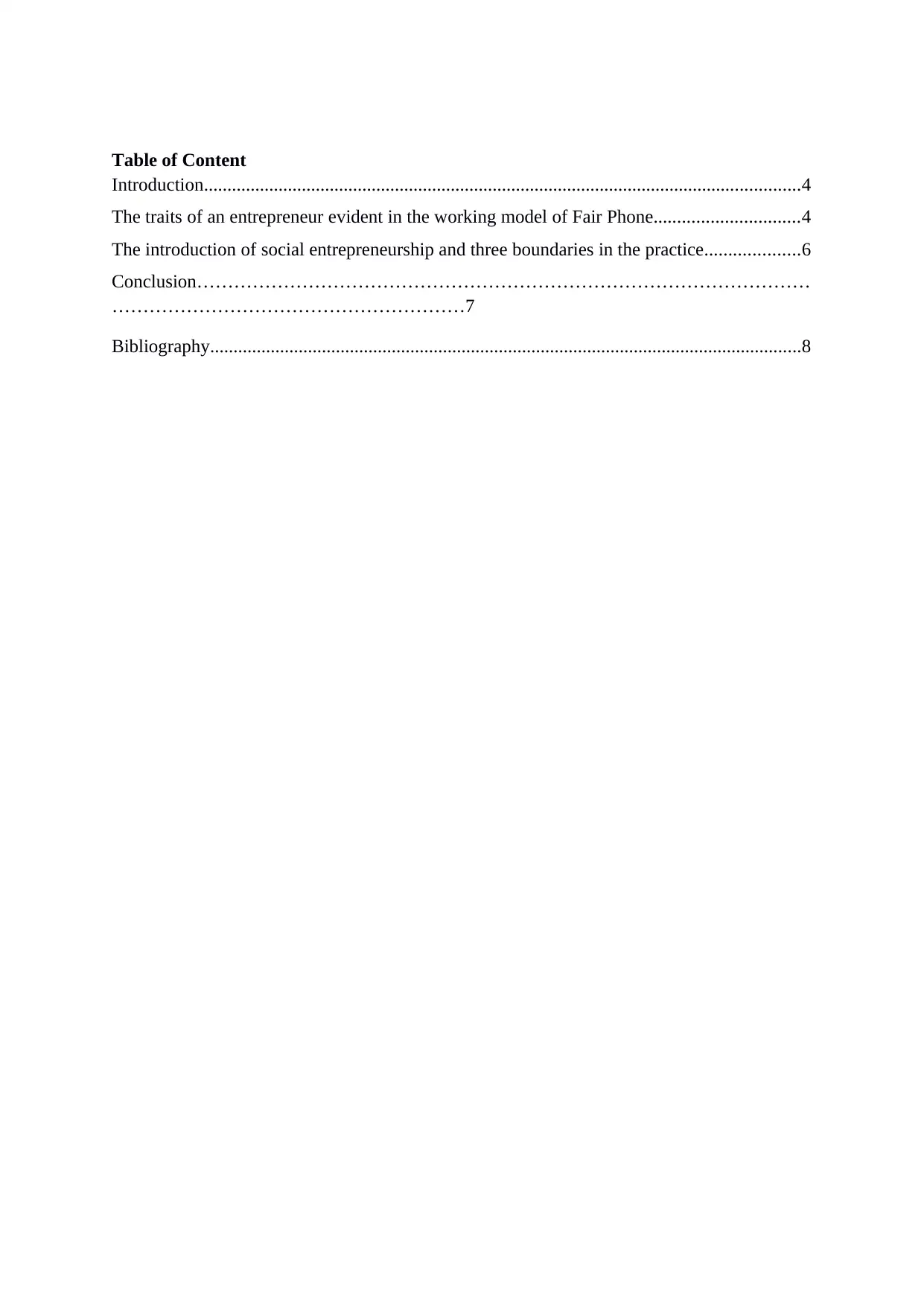
Table of Content
Introduction................................................................................................................................4
The traits of an entrepreneur evident in the working model of Fair Phone...............................4
The introduction of social entrepreneurship and three boundaries in the practice....................6
Conclusion………………………………………………………………………………………
…………………………………………………7
Bibliography...............................................................................................................................8
Introduction................................................................................................................................4
The traits of an entrepreneur evident in the working model of Fair Phone...............................4
The introduction of social entrepreneurship and three boundaries in the practice....................6
Conclusion………………………………………………………………………………………
…………………………………………………7
Bibliography...............................................................................................................................8
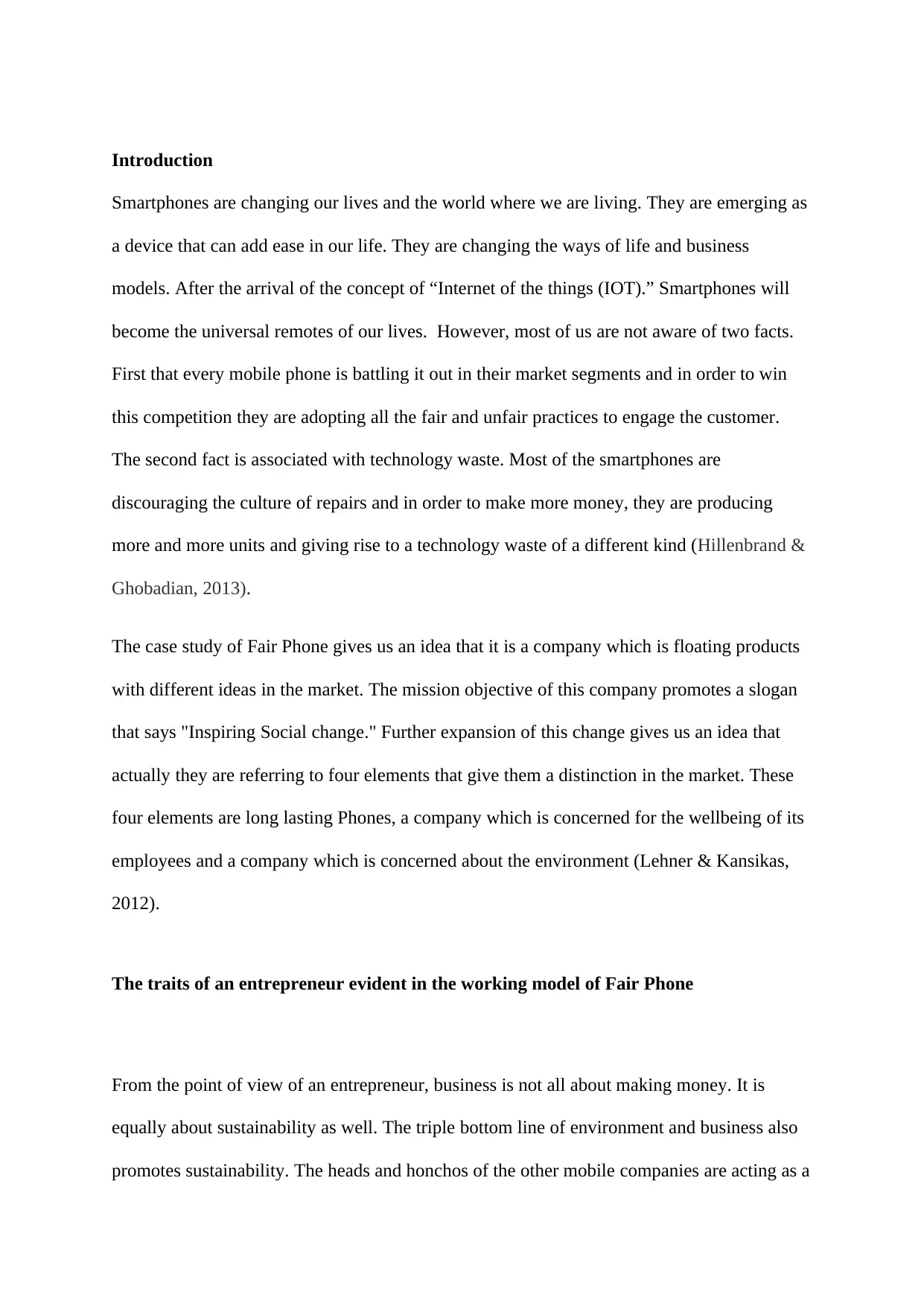
Introduction
Smartphones are changing our lives and the world where we are living. They are emerging as
a device that can add ease in our life. They are changing the ways of life and business
models. After the arrival of the concept of “Internet of the things (IOT).” Smartphones will
become the universal remotes of our lives. However, most of us are not aware of two facts.
First that every mobile phone is battling it out in their market segments and in order to win
this competition they are adopting all the fair and unfair practices to engage the customer.
The second fact is associated with technology waste. Most of the smartphones are
discouraging the culture of repairs and in order to make more money, they are producing
more and more units and giving rise to a technology waste of a different kind (Hillenbrand &
Ghobadian, 2013).
The case study of Fair Phone gives us an idea that it is a company which is floating products
with different ideas in the market. The mission objective of this company promotes a slogan
that says "Inspiring Social change." Further expansion of this change gives us an idea that
actually they are referring to four elements that give them a distinction in the market. These
four elements are long lasting Phones, a company which is concerned for the wellbeing of its
employees and a company which is concerned about the environment (Lehner & Kansikas,
2012).
The traits of an entrepreneur evident in the working model of Fair Phone
From the point of view of an entrepreneur, business is not all about making money. It is
equally about sustainability as well. The triple bottom line of environment and business also
promotes sustainability. The heads and honchos of the other mobile companies are acting as a
Smartphones are changing our lives and the world where we are living. They are emerging as
a device that can add ease in our life. They are changing the ways of life and business
models. After the arrival of the concept of “Internet of the things (IOT).” Smartphones will
become the universal remotes of our lives. However, most of us are not aware of two facts.
First that every mobile phone is battling it out in their market segments and in order to win
this competition they are adopting all the fair and unfair practices to engage the customer.
The second fact is associated with technology waste. Most of the smartphones are
discouraging the culture of repairs and in order to make more money, they are producing
more and more units and giving rise to a technology waste of a different kind (Hillenbrand &
Ghobadian, 2013).
The case study of Fair Phone gives us an idea that it is a company which is floating products
with different ideas in the market. The mission objective of this company promotes a slogan
that says "Inspiring Social change." Further expansion of this change gives us an idea that
actually they are referring to four elements that give them a distinction in the market. These
four elements are long lasting Phones, a company which is concerned for the wellbeing of its
employees and a company which is concerned about the environment (Lehner & Kansikas,
2012).
The traits of an entrepreneur evident in the working model of Fair Phone
From the point of view of an entrepreneur, business is not all about making money. It is
equally about sustainability as well. The triple bottom line of environment and business also
promotes sustainability. The heads and honchos of the other mobile companies are acting as a
Secure Best Marks with AI Grader
Need help grading? Try our AI Grader for instant feedback on your assignments.
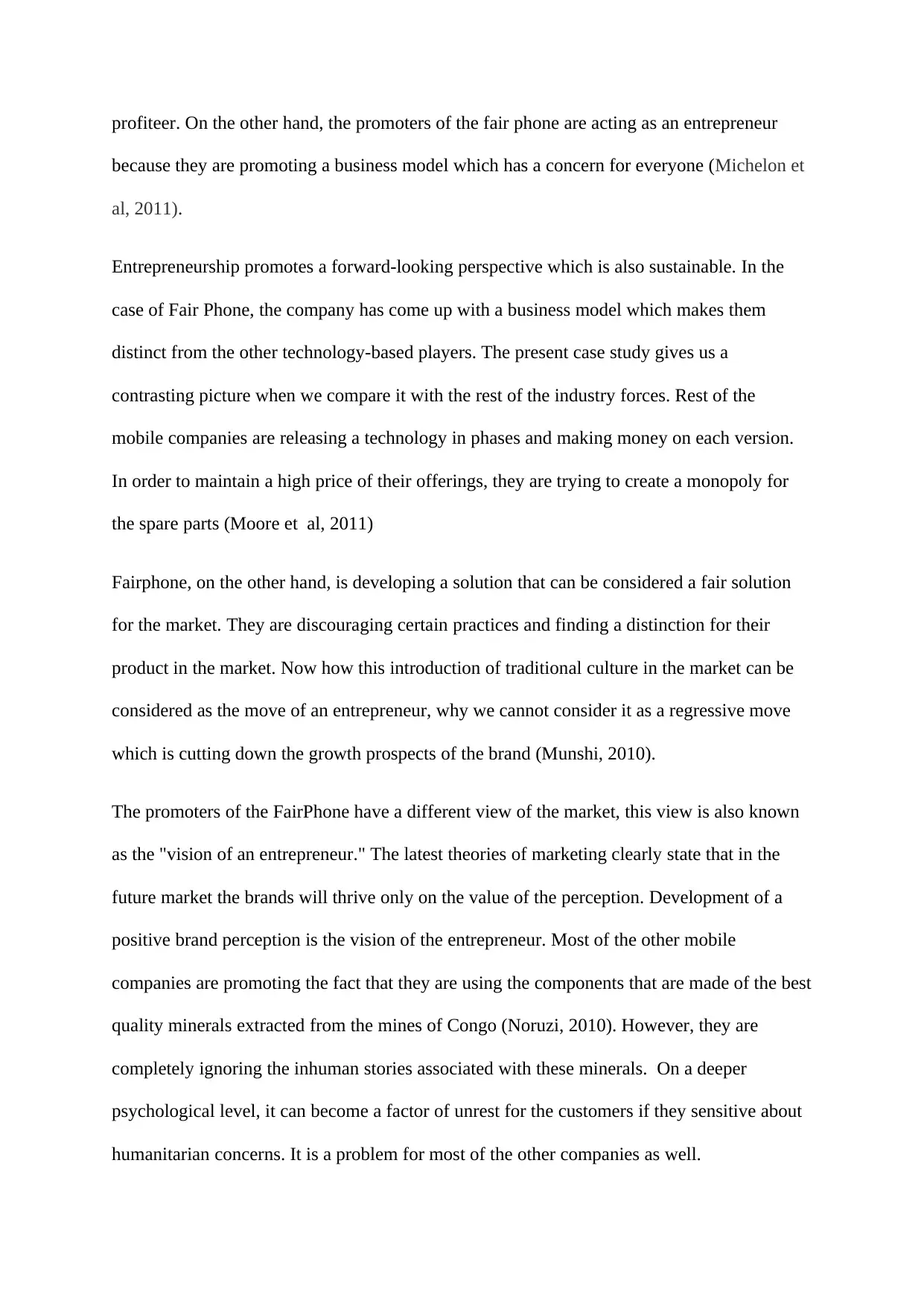
profiteer. On the other hand, the promoters of the fair phone are acting as an entrepreneur
because they are promoting a business model which has a concern for everyone (Michelon et
al, 2011).
Entrepreneurship promotes a forward-looking perspective which is also sustainable. In the
case of Fair Phone, the company has come up with a business model which makes them
distinct from the other technology-based players. The present case study gives us a
contrasting picture when we compare it with the rest of the industry forces. Rest of the
mobile companies are releasing a technology in phases and making money on each version.
In order to maintain a high price of their offerings, they are trying to create a monopoly for
the spare parts (Moore et al, 2011)
Fairphone, on the other hand, is developing a solution that can be considered a fair solution
for the market. They are discouraging certain practices and finding a distinction for their
product in the market. Now how this introduction of traditional culture in the market can be
considered as the move of an entrepreneur, why we cannot consider it as a regressive move
which is cutting down the growth prospects of the brand (Munshi, 2010).
The promoters of the FairPhone have a different view of the market, this view is also known
as the "vision of an entrepreneur." The latest theories of marketing clearly state that in the
future market the brands will thrive only on the value of the perception. Development of a
positive brand perception is the vision of the entrepreneur. Most of the other mobile
companies are promoting the fact that they are using the components that are made of the best
quality minerals extracted from the mines of Congo (Noruzi, 2010). However, they are
completely ignoring the inhuman stories associated with these minerals. On a deeper
psychological level, it can become a factor of unrest for the customers if they sensitive about
humanitarian concerns. It is a problem for most of the other companies as well.
because they are promoting a business model which has a concern for everyone (Michelon et
al, 2011).
Entrepreneurship promotes a forward-looking perspective which is also sustainable. In the
case of Fair Phone, the company has come up with a business model which makes them
distinct from the other technology-based players. The present case study gives us a
contrasting picture when we compare it with the rest of the industry forces. Rest of the
mobile companies are releasing a technology in phases and making money on each version.
In order to maintain a high price of their offerings, they are trying to create a monopoly for
the spare parts (Moore et al, 2011)
Fairphone, on the other hand, is developing a solution that can be considered a fair solution
for the market. They are discouraging certain practices and finding a distinction for their
product in the market. Now how this introduction of traditional culture in the market can be
considered as the move of an entrepreneur, why we cannot consider it as a regressive move
which is cutting down the growth prospects of the brand (Munshi, 2010).
The promoters of the FairPhone have a different view of the market, this view is also known
as the "vision of an entrepreneur." The latest theories of marketing clearly state that in the
future market the brands will thrive only on the value of the perception. Development of a
positive brand perception is the vision of the entrepreneur. Most of the other mobile
companies are promoting the fact that they are using the components that are made of the best
quality minerals extracted from the mines of Congo (Noruzi, 2010). However, they are
completely ignoring the inhuman stories associated with these minerals. On a deeper
psychological level, it can become a factor of unrest for the customers if they sensitive about
humanitarian concerns. It is a problem for most of the other companies as well.
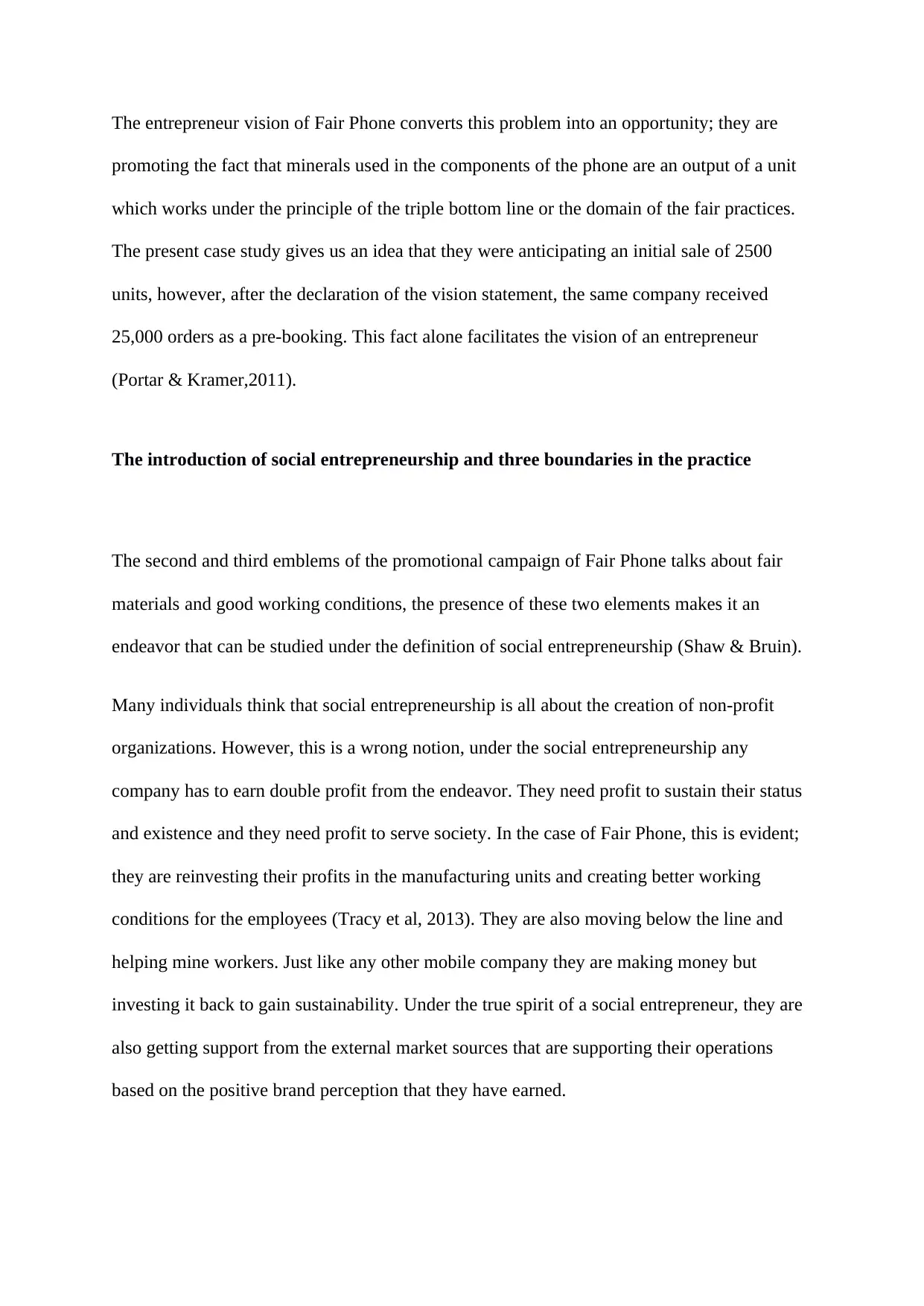
The entrepreneur vision of Fair Phone converts this problem into an opportunity; they are
promoting the fact that minerals used in the components of the phone are an output of a unit
which works under the principle of the triple bottom line or the domain of the fair practices.
The present case study gives us an idea that they were anticipating an initial sale of 2500
units, however, after the declaration of the vision statement, the same company received
25,000 orders as a pre-booking. This fact alone facilitates the vision of an entrepreneur
(Portar & Kramer,2011).
The introduction of social entrepreneurship and three boundaries in the practice
The second and third emblems of the promotional campaign of Fair Phone talks about fair
materials and good working conditions, the presence of these two elements makes it an
endeavor that can be studied under the definition of social entrepreneurship (Shaw & Bruin).
Many individuals think that social entrepreneurship is all about the creation of non-profit
organizations. However, this is a wrong notion, under the social entrepreneurship any
company has to earn double profit from the endeavor. They need profit to sustain their status
and existence and they need profit to serve society. In the case of Fair Phone, this is evident;
they are reinvesting their profits in the manufacturing units and creating better working
conditions for the employees (Tracy et al, 2013). They are also moving below the line and
helping mine workers. Just like any other mobile company they are making money but
investing it back to gain sustainability. Under the true spirit of a social entrepreneur, they are
also getting support from the external market sources that are supporting their operations
based on the positive brand perception that they have earned.
promoting the fact that minerals used in the components of the phone are an output of a unit
which works under the principle of the triple bottom line or the domain of the fair practices.
The present case study gives us an idea that they were anticipating an initial sale of 2500
units, however, after the declaration of the vision statement, the same company received
25,000 orders as a pre-booking. This fact alone facilitates the vision of an entrepreneur
(Portar & Kramer,2011).
The introduction of social entrepreneurship and three boundaries in the practice
The second and third emblems of the promotional campaign of Fair Phone talks about fair
materials and good working conditions, the presence of these two elements makes it an
endeavor that can be studied under the definition of social entrepreneurship (Shaw & Bruin).
Many individuals think that social entrepreneurship is all about the creation of non-profit
organizations. However, this is a wrong notion, under the social entrepreneurship any
company has to earn double profit from the endeavor. They need profit to sustain their status
and existence and they need profit to serve society. In the case of Fair Phone, this is evident;
they are reinvesting their profits in the manufacturing units and creating better working
conditions for the employees (Tracy et al, 2013). They are also moving below the line and
helping mine workers. Just like any other mobile company they are making money but
investing it back to gain sustainability. Under the true spirit of a social entrepreneur, they are
also getting support from the external market sources that are supporting their operations
based on the positive brand perception that they have earned.
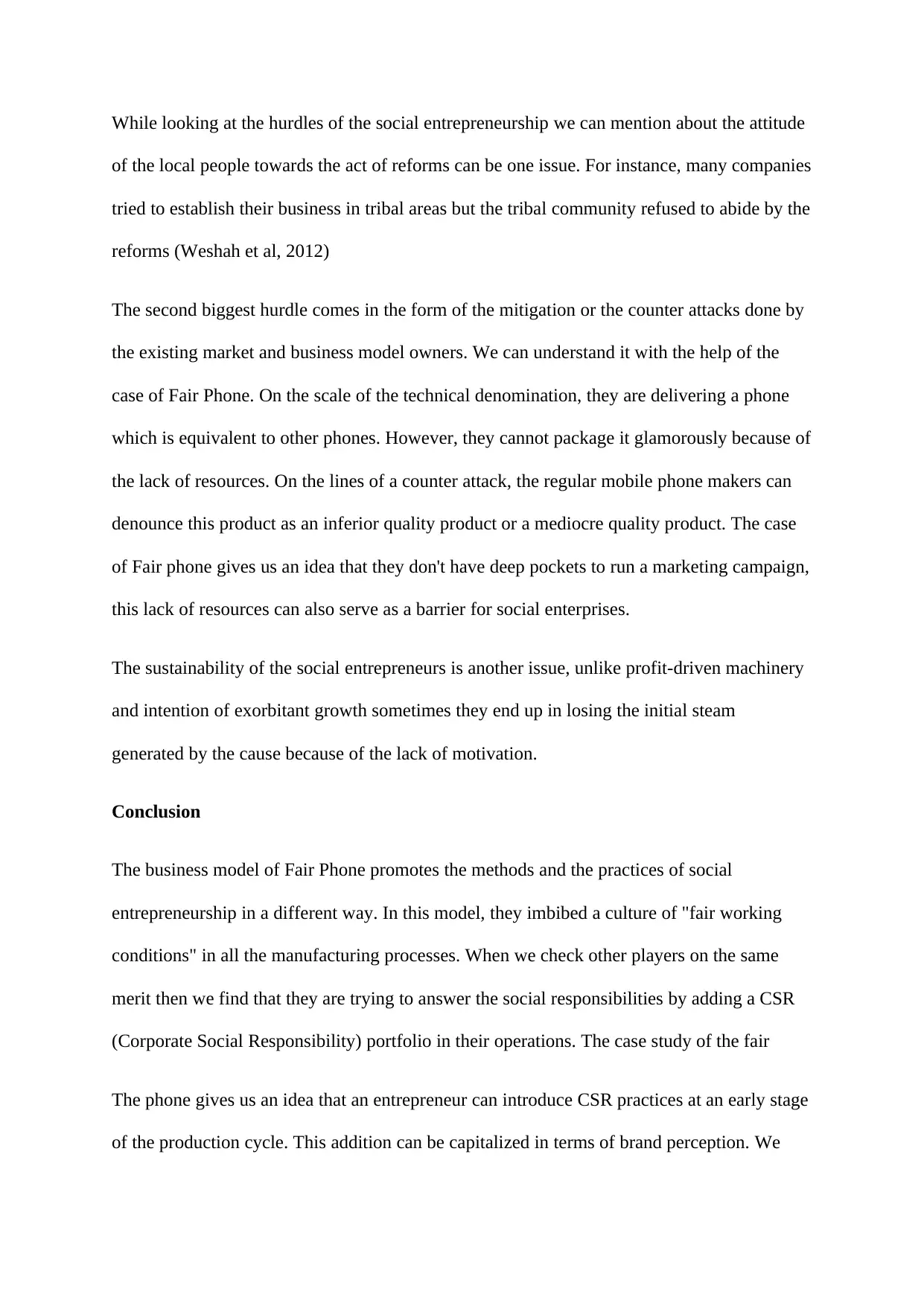
While looking at the hurdles of the social entrepreneurship we can mention about the attitude
of the local people towards the act of reforms can be one issue. For instance, many companies
tried to establish their business in tribal areas but the tribal community refused to abide by the
reforms (Weshah et al, 2012)
The second biggest hurdle comes in the form of the mitigation or the counter attacks done by
the existing market and business model owners. We can understand it with the help of the
case of Fair Phone. On the scale of the technical denomination, they are delivering a phone
which is equivalent to other phones. However, they cannot package it glamorously because of
the lack of resources. On the lines of a counter attack, the regular mobile phone makers can
denounce this product as an inferior quality product or a mediocre quality product. The case
of Fair phone gives us an idea that they don't have deep pockets to run a marketing campaign,
this lack of resources can also serve as a barrier for social enterprises.
The sustainability of the social entrepreneurs is another issue, unlike profit-driven machinery
and intention of exorbitant growth sometimes they end up in losing the initial steam
generated by the cause because of the lack of motivation.
Conclusion
The business model of Fair Phone promotes the methods and the practices of social
entrepreneurship in a different way. In this model, they imbibed a culture of "fair working
conditions" in all the manufacturing processes. When we check other players on the same
merit then we find that they are trying to answer the social responsibilities by adding a CSR
(Corporate Social Responsibility) portfolio in their operations. The case study of the fair
The phone gives us an idea that an entrepreneur can introduce CSR practices at an early stage
of the production cycle. This addition can be capitalized in terms of brand perception. We
of the local people towards the act of reforms can be one issue. For instance, many companies
tried to establish their business in tribal areas but the tribal community refused to abide by the
reforms (Weshah et al, 2012)
The second biggest hurdle comes in the form of the mitigation or the counter attacks done by
the existing market and business model owners. We can understand it with the help of the
case of Fair Phone. On the scale of the technical denomination, they are delivering a phone
which is equivalent to other phones. However, they cannot package it glamorously because of
the lack of resources. On the lines of a counter attack, the regular mobile phone makers can
denounce this product as an inferior quality product or a mediocre quality product. The case
of Fair phone gives us an idea that they don't have deep pockets to run a marketing campaign,
this lack of resources can also serve as a barrier for social enterprises.
The sustainability of the social entrepreneurs is another issue, unlike profit-driven machinery
and intention of exorbitant growth sometimes they end up in losing the initial steam
generated by the cause because of the lack of motivation.
Conclusion
The business model of Fair Phone promotes the methods and the practices of social
entrepreneurship in a different way. In this model, they imbibed a culture of "fair working
conditions" in all the manufacturing processes. When we check other players on the same
merit then we find that they are trying to answer the social responsibilities by adding a CSR
(Corporate Social Responsibility) portfolio in their operations. The case study of the fair
The phone gives us an idea that an entrepreneur can introduce CSR practices at an early stage
of the production cycle. This addition can be capitalized in terms of brand perception. We
Paraphrase This Document
Need a fresh take? Get an instant paraphrase of this document with our AI Paraphraser

started this compilation of the facts on a note where we talked about the Triple bottom line of
the operations. Tools like triple bottom line can add a positive brand perception in any
product, in the coming future we can see more Smartphone brands and other brands where
the exercise of adding fair values in the brand will act as an advertising capital.
the operations. Tools like triple bottom line can add a positive brand perception in any
product, in the coming future we can see more Smartphone brands and other brands where
the exercise of adding fair values in the brand will act as an advertising capital.
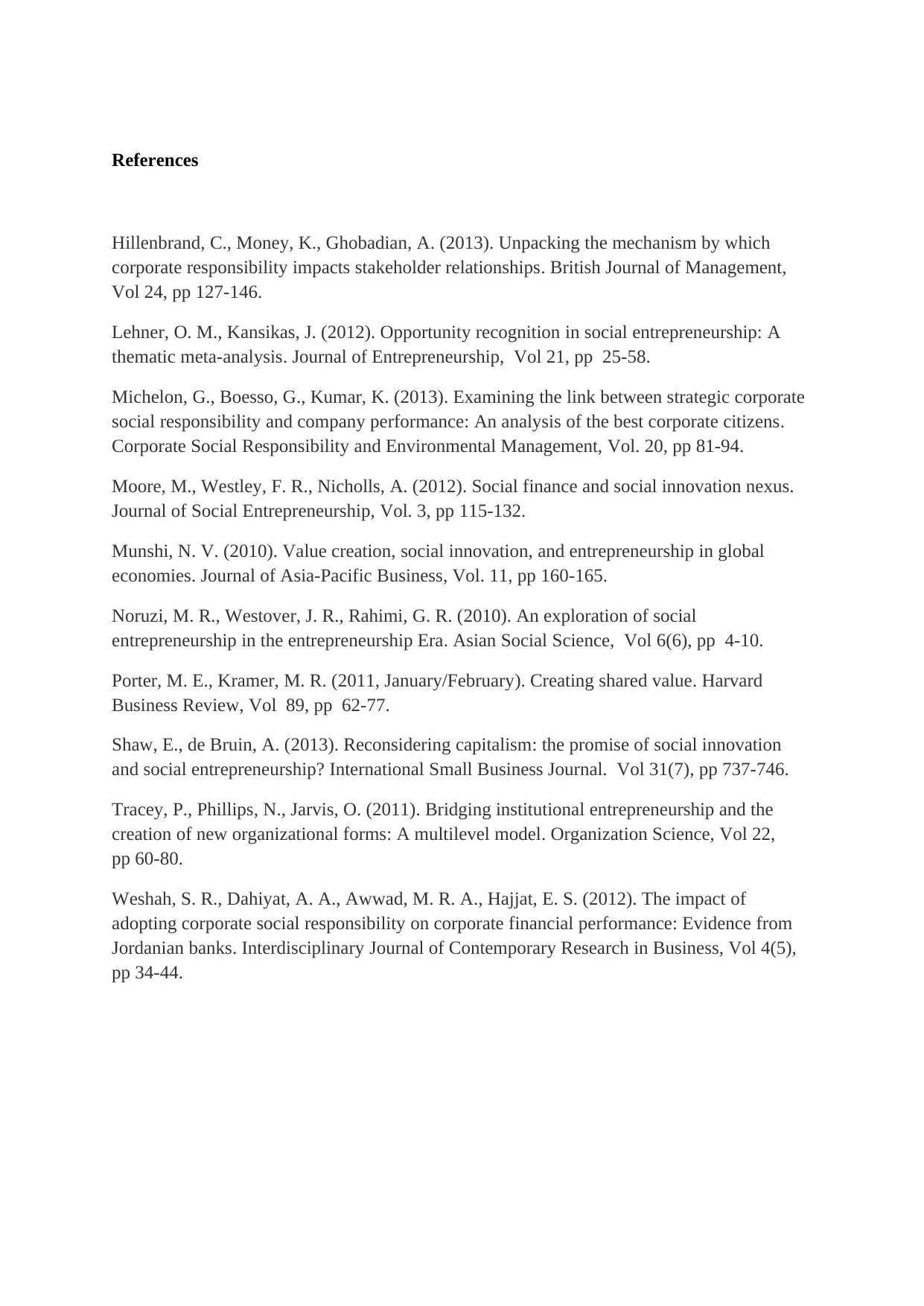
References
Hillenbrand, C., Money, K., Ghobadian, A. (2013). Unpacking the mechanism by which
corporate responsibility impacts stakeholder relationships. British Journal of Management,
Vol 24, pp 127-146.
Lehner, O. M., Kansikas, J. (2012). Opportunity recognition in social entrepreneurship: A
thematic meta-analysis. Journal of Entrepreneurship, Vol 21, pp 25-58.
Michelon, G., Boesso, G., Kumar, K. (2013). Examining the link between strategic corporate
social responsibility and company performance: An analysis of the best corporate citizens.
Corporate Social Responsibility and Environmental Management, Vol. 20, pp 81-94.
Moore, M., Westley, F. R., Nicholls, A. (2012). Social finance and social innovation nexus.
Journal of Social Entrepreneurship, Vol. 3, pp 115-132.
Munshi, N. V. (2010). Value creation, social innovation, and entrepreneurship in global
economies. Journal of Asia-Pacific Business, Vol. 11, pp 160-165.
Noruzi, M. R., Westover, J. R., Rahimi, G. R. (2010). An exploration of social
entrepreneurship in the entrepreneurship Era. Asian Social Science, Vol 6(6), pp 4-10.
Porter, M. E., Kramer, M. R. (2011, January/February). Creating shared value. Harvard
Business Review, Vol 89, pp 62-77.
Shaw, E., de Bruin, A. (2013). Reconsidering capitalism: the promise of social innovation
and social entrepreneurship? International Small Business Journal. Vol 31(7), pp 737-746.
Tracey, P., Phillips, N., Jarvis, O. (2011). Bridging institutional entrepreneurship and the
creation of new organizational forms: A multilevel model. Organization Science, Vol 22,
pp 60-80.
Weshah, S. R., Dahiyat, A. A., Awwad, M. R. A., Hajjat, E. S. (2012). The impact of
adopting corporate social responsibility on corporate financial performance: Evidence from
Jordanian banks. Interdisciplinary Journal of Contemporary Research in Business, Vol 4(5),
pp 34-44.
Hillenbrand, C., Money, K., Ghobadian, A. (2013). Unpacking the mechanism by which
corporate responsibility impacts stakeholder relationships. British Journal of Management,
Vol 24, pp 127-146.
Lehner, O. M., Kansikas, J. (2012). Opportunity recognition in social entrepreneurship: A
thematic meta-analysis. Journal of Entrepreneurship, Vol 21, pp 25-58.
Michelon, G., Boesso, G., Kumar, K. (2013). Examining the link between strategic corporate
social responsibility and company performance: An analysis of the best corporate citizens.
Corporate Social Responsibility and Environmental Management, Vol. 20, pp 81-94.
Moore, M., Westley, F. R., Nicholls, A. (2012). Social finance and social innovation nexus.
Journal of Social Entrepreneurship, Vol. 3, pp 115-132.
Munshi, N. V. (2010). Value creation, social innovation, and entrepreneurship in global
economies. Journal of Asia-Pacific Business, Vol. 11, pp 160-165.
Noruzi, M. R., Westover, J. R., Rahimi, G. R. (2010). An exploration of social
entrepreneurship in the entrepreneurship Era. Asian Social Science, Vol 6(6), pp 4-10.
Porter, M. E., Kramer, M. R. (2011, January/February). Creating shared value. Harvard
Business Review, Vol 89, pp 62-77.
Shaw, E., de Bruin, A. (2013). Reconsidering capitalism: the promise of social innovation
and social entrepreneurship? International Small Business Journal. Vol 31(7), pp 737-746.
Tracey, P., Phillips, N., Jarvis, O. (2011). Bridging institutional entrepreneurship and the
creation of new organizational forms: A multilevel model. Organization Science, Vol 22,
pp 60-80.
Weshah, S. R., Dahiyat, A. A., Awwad, M. R. A., Hajjat, E. S. (2012). The impact of
adopting corporate social responsibility on corporate financial performance: Evidence from
Jordanian banks. Interdisciplinary Journal of Contemporary Research in Business, Vol 4(5),
pp 34-44.

1 out of 10
Related Documents
Your All-in-One AI-Powered Toolkit for Academic Success.
+13062052269
info@desklib.com
Available 24*7 on WhatsApp / Email
![[object Object]](/_next/static/media/star-bottom.7253800d.svg)
Unlock your academic potential
© 2024 | Zucol Services PVT LTD | All rights reserved.




